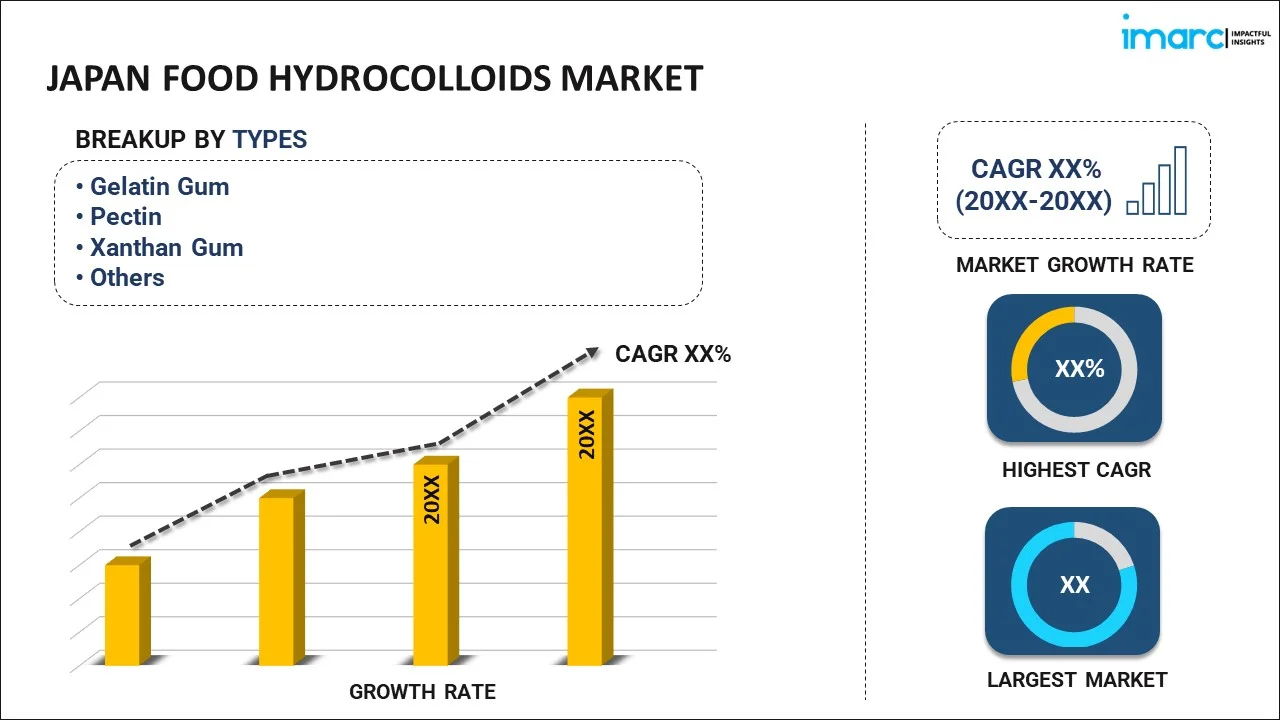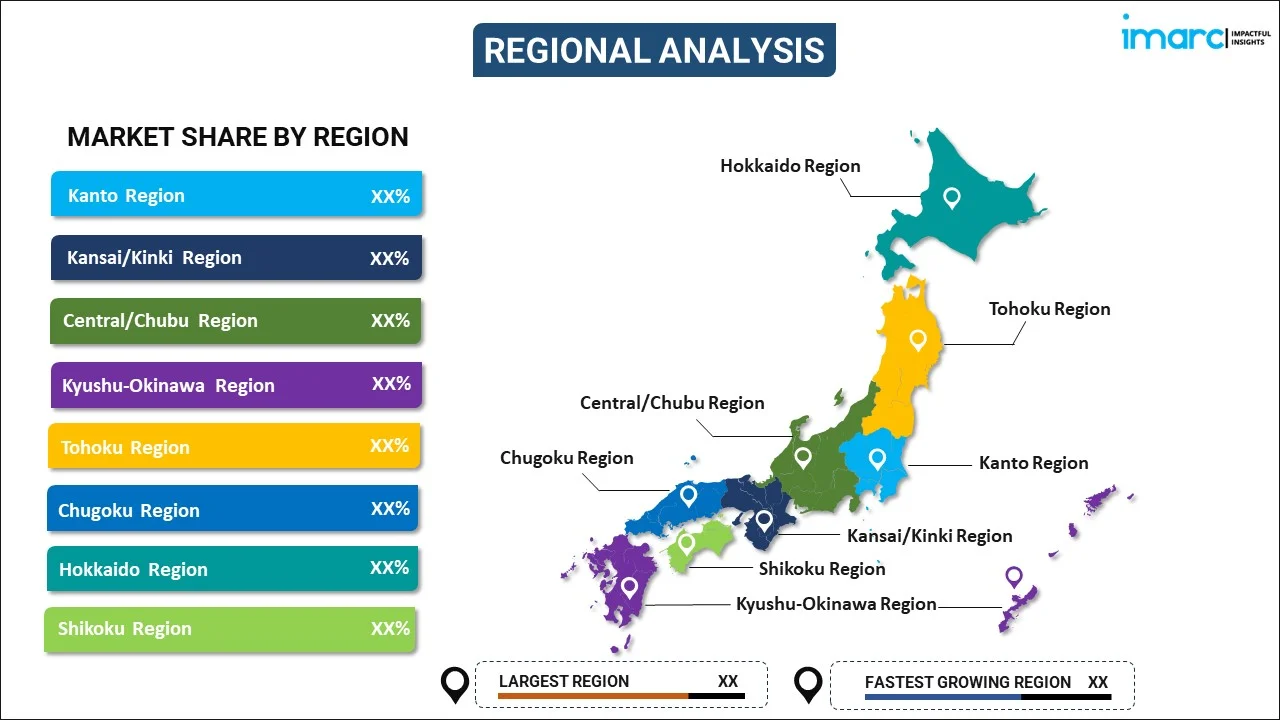
Japan Food Hydrocolloids Market Report by Type (Gelatin Gum, Pectin, Xanthan Gum, Guar Gum, Carrageenan, and Others), Application (Dairy and Frozen Products, Bakery, Beverages, Confectionery, Meat and Seafood Products, Oils and Fats, and Others), and Region 2025-2033
Market Overview:
Japan food hydrocolloids market size reached USD 393.2 Million in 2024. Looking forward, IMARC Group expects the market to reach USD 584.4 Million by 2033, exhibiting a growth rate (CAGR) of 4.28% during 2025-2033. The inflating popularity of vegan and plant-based diets coupled with the emerging application of hydrocolloids to mimic the texture and mouthfeel of animal-derived products in meat substitutes, dairy alternatives, and other plant-based foods is primarily driving the market.
|
Report Attribute
|
Key Statistics
|
|---|---|
|
Base Year
|
2024 |
|
Forecast Years
|
2025-2033 |
|
Historical Years
|
2019-2024
|
| Market Size in 2024 | USD 393.2 Million |
| Market Forecast in 2033 | USD 584.4 Million |
| Market Growth Rate (2025-2033) | 4.28% |
Food hydrocolloids are substances used in the food industry to modify the texture, stability, and sensory properties of various food products. These hydrocolloids are typically water-soluble polymers derived from natural sources like plants, seaweed, and microbial fermentation. They have the unique ability to form gels, thicken liquids, and stabilize emulsions due to their water-binding and thickening properties. Common food hydrocolloids include agar, carrageenan, pectin, guar gum, xanthan gum, and cellulose derivatives. They find widespread application in various food products such as sauces, dressings, bakery items, dairy products, and meat products. Food hydrocolloids play vital roles in enhancing the mouthfeel, shelf life, and overall quality of foods. They can control moisture, prevent syneresis (separation of liquids), and improve the texture of foods, making them more appealing to consumers. Additionally, they can act as fat replacers and reduce calorie content in certain products. Their versatility and functionality make them valuable tools in food formulation and processing, contributing to the development of innovative and improved food products.
Japan Food Hydrocolloids Market Trends:
The market for food hydrocolloids in Japan is experiencing robust growth, driven predominantly by several factors. Firstly, consumers' growing health consciousness and the pursuit of healthier dietary choices have propelled the demand for hydrocolloids. These versatile compounds, including guar gum, carrageenan, and pectin, are indispensable in formulating low-fat and low-sugar products that cater to health-conscious consumers. Additionally, the regional trend toward convenience foods and ready-to-eat meals has spurred the use of hydrocolloids for texture enhancement, stability, and shelf-life extension. Furthermore, the increasing prevalence of dietary restrictions, such as gluten intolerance and veganism, has driven the need for hydrocolloids as effective replacements for traditional ingredients, ensuring the development of inclusive food products. Moreover, the expanding population and urbanization in Japan that led to changes in consumption patterns, with a preference for processed and packaged foods, is further boosting the food hydrocolloids market. Lastly, the emphasis on sustainability and reduced food waste, which can increase the adoption of hydrocolloids in food preservation and reduction of spoilage, is expected to drive the regional market.
Japan Food Hydrocolloids Market Segmentation:
IMARC Group provides an analysis of the key trends in each segment of the market, along with forecasts at the country level for 2025-2033. Our report has categorized the market based on type and application.
Type Insights:

- Gelatin Gum
- Pectin
- Xanthan Gum
- Guar Gum
- Carrageenan
- Others
The report has provided a detailed breakup and analysis of the market based on the type. This includes gelatin gum, pectin, xanthan gum, guar gum, carrageenan, and others.
Application Insights:
- Dairy and Frozen Products
- Bakery
- Beverages
- Confectionery
- Meat and Seafood Products
- Oils and Fats
- Others
A detailed breakup and analysis of the market based on the application have also been provided in the report. This includes dairy and frozen products, bakery, beverages, confectionery, meat and seafood products, oils and fats, and others.
Regional Insights:

- Kanto Region
- Kansai/Kinki Region
- Central/ Chubu Region
- Kyushu-Okinawa Region
- Tohoku Region
- Chugoku Region
- Hokkaido Region
- Shikoku Region
The report has also provided a comprehensive analysis of all the major regional markets, which include Kanto Region, Kansai/Kinki Region, Central/ Chubu Region, Kyushu-Okinawa Region, Tohoku Region, Chugoku Region, Hokkaido Region, and Shikoku Region.
Competitive Landscape:
The market research report has also provided a comprehensive analysis of the competitive landscape. Competitive analysis such as market structure, key player positioning, top winning strategies, competitive dashboard, and company evaluation quadrant has been covered in the report. Also, detailed profiles of all major companies have been provided.
Japan Food Hydrocolloids Market Report Coverage:
| Report Features | Details |
|---|---|
| Base Year of the Analysis | 2024 |
| Historical Period | 2019-2024 |
| Forecast Period | 2025-2033 |
| Units | Million USD |
| Scope of the Report | Exploration of Historical Trends and Market Outlook, Industry Catalysts and Challenges, Segment-Wise Historical and Future Market Assessment:
|
| Types Covered | Gelatin Gum, Pectin, Xanthan Gum, Guar Gum, Carrageenan, Others |
| Applications Covered | Dairy and Frozen Products, Bakery, Beverages, Confectionery, Meat and Seafood Products, Oils and Fats, Others |
| Regions Covered | Kanto Region, Kansai/Kinki Region, Central/ Chubu Region, Kyushu-Okinawa Region, Tohoku Region, Chugoku Region, Hokkaido Region, Shikoku Region |
| Customization Scope | 10% Free Customization |
| Post-Sale Analyst Support | 10-12 Weeks |
| Delivery Format | PDF and Excel through Email (We can also provide the editable version of the report in PPT/Word format on special request) |
Key Questions Answered in This Report:
- How has the Japan food hydrocolloids market performed so far and how will it perform in the coming years?
- What has been the impact of COVID-19 on the Japan food hydrocolloids market?
- What is the breakup of the Japan food hydrocolloids market on the basis of type?
- What is the breakup of the Japan food hydrocolloids market on the basis of application?
- What are the various stages in the value chain of the Japan food hydrocolloids market?
- What are the key driving factors and challenges in the Japan food hydrocolloids?
- What is the structure of the Japan food hydrocolloids market and who are the key players?
- What is the degree of competition in the Japan food hydrocolloids market?
Key Benefits for Stakeholders:
- IMARC’s industry report offers a comprehensive quantitative analysis of various market segments, historical and current market trends, market forecasts, and dynamics of the Japan food hydrocolloids market from 2019-2033.
- The research report provides the latest information on the market drivers, challenges, and opportunities in the Japan food hydrocolloids market.
- Porter's five forces analysis assist stakeholders in assessing the impact of new entrants, competitive rivalry, supplier power, buyer power, and the threat of substitution. It helps stakeholders to analyze the level of competition within the Japan food hydrocolloids industry and its attractiveness.
- Competitive landscape allows stakeholders to understand their competitive environment and provides an insight into the current positions of key players in the market.
Need more help?
- Speak to our experienced analysts for insights on the current market scenarios.
- Include additional segments and countries to customize the report as per your requirement.
- Gain an unparalleled competitive advantage in your domain by understanding how to utilize the report and positively impacting your operations and revenue.
- For further assistance, please connect with our analysts.
 Inquire Before Buying
Inquire Before Buying
 Speak to an Analyst
Speak to an Analyst
 Request Brochure
Request Brochure
 Request Customization
Request Customization




.webp)




.webp)












